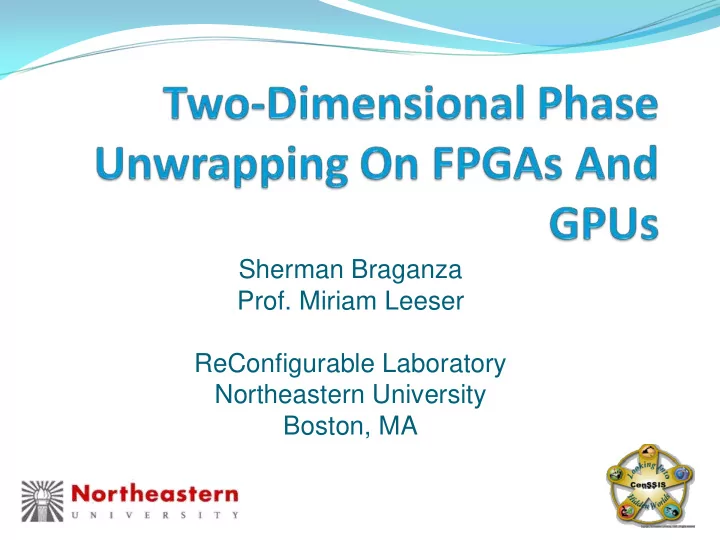

Sherman Braganza Prof. Miriam Leeser ReConfigurable Laboratory Northeastern University Boston, MA
Outline � Introduction � Motivation Optical Quadrature Microscopy � Phase unwrapping � � Algorithms � Minimum L P norm phase unwrapping � Platforms Reconfigurable Hardware and Graphics Processors � � Implementation � FPGA and GPU specifics � Verification details � Results � Performance � Power � Cost � Conclusions and Future Work
Motivation – Why Bother With Phase Unwrapping? � Used in phase based imaging applications � IFSAR, OQM microscopy � High quality results are computationally expensive � Only difficult in 2D or higher Wrapped embryo image � Integrating gradients with noisy data 0.1 0.3 0.1 0.3 � Residues and path ‐ 0.1 ‐ 0.3 ‐ 0.1 ‐ 0.2 dependency No residues Residues
Algorithms – Which One Do We Choose? � Many phase unwrapping algorithms � Goldstein’s, Flynns, Quality maps, Mask Cuts, multi-grid, PCG, Minimum LP norm (Ghiglia and Pritt, “ Two Dimensional Phase Unwrapping ”, Wiley, NY, 1998. � We need: High quality (performance is secondary) � Abilitity to handle noisy data � Choose Minimum L P Norm algorithm: Has the highest computational cost a) Software embryo unwrap b) Software embryo unwrap Using Minimum L P Norm Using matlab ‘unwrap’
Breaking Down Minimum LP Norm � Minimizes existence of differences between measured data and calculated data � Iterates Preconditioned Conjugate Gradient (PCG) � 94% of total computation time � Also iterative � Two steps to PCG � Preconditioner (2D DCT, Poisson calculation and 2D IDCT) � Conjugate Gradient
Platforms – Which Accelerator Is Best For Phase Unwrapping? � FPGAs � Fine grained control � Highly parallel � Limited program memory � Floating point? � High implementation cost Xilinx Virtex II Pro architecture http://www.xilinx.com/
Platforms ‐ GPUs G80 Architecture [nvidia.com/cuda]
Platform Comparison FPGAs GPUs •Absolute control: Can specific custom •Need to fit application to bit-widths/architectures to optimally architecture suit application •Can have fast processor-processor •Multiprocessor-multiprocessor communication communication is slow •Low clock frequency •Higher frequency •High degree of implementation •Relatively straightforward to freedom => higher implementation develop for. Uses standard C syntax effort. VHDL. •Small program space. High •Relatively large program space. reprogramming time Low reprogramming time.
Platform Description • FPGA and GPU on different platforms 4 years apart • Effects of Moore’s Law Platform specifications • Machine 3 in the Results: Cost section has a Virtex 5 and two Core2Quads Software unwrap execution time
Implementation: Preconditioning On An FPGA � Need to account for bitwidth � Minimum of 28 bit needed – Use 24 bit + block exponent � Implement a 2D 1024x512 DCT/IDCT using 1D row/column decomposition � Implement a streaming floating point kernel to solve discretized Poisson equation 27 bit software unwrap 28 bit software unwrap
Minimum L P Norm On A GPU � NVIDIA provides 2D FFT kernel � Use to compute 2D DCT � Can use CUDA to implement floating point solver � Few accuracy issues � No area constraints on GPU � Why not implement whole algorithm? � Multiple kernels, each computing one CG or L P norm step � One host to accelerator transfer per unwrap
Verifying Our Implementations � Look at residue counts as algorithm progresses � Less than 0.1% difference � Visual inspection: Glass bead gives worst case results Software unwrap GPU unwrap FPGA unwrap
Verifying Our Implementations � Differences between software and accelerated version GPU vs. Software FPGA vs. Software
Results: FPGA � Implemented preconditioner in hardware and measured algorithm speedup � Maximum speedup assuming zero preconditioning calculation time : 3.9x � We get 2.35x on a V2P70, 3.69x on a V5 (projected)
Results: GPU � Implemented entire LP norm kernel on GPU and measured algorithm speedup � Speedups for all sections except disk IO � 5.24x algorithm speedup. 6.86x without disk IO
Results: FPGAs vs. GPUs � Preconditioning only � Similar platform generation. Projected FPGA results. � Includes FPGA data transfer, not GPU � Buses? Currently use PCI-X for FPGA, PCI-E for GPU
Results: Power � GPU power consumption increases significantly � FPGA power decreases Power consumption (W)
Cost Machine 2 $2200 Machine 3 $10000 � Machine 3 includes an AlphaData board with a Xilinx Virtex 5 FPGA platform and two Core2Quads � Performance is given by 1/T exec � Proportional to FLOPs
Performance To Watt ‐ Dollars • Metric to include all parameters
Conclusions And Future Work � For phase unwrapping GPUs provide higher performance � Higher power consumption � FPGAs have low power consumption � High reprogramming time � OQM: GPUs are the best fit. Cost effective and faster: � Images already on processor � FPGAs have a much stronger appeal in the embedded domain � Future Work � Experiment with new GPUs (GTX 280) and platforms (Cell, Larrabee, 4x2 multicore) � Multi-FPGA implementation
Thank You! Any Questions? Sherman Braganza (braganza.s@neu.edu) Miriam Leeser (mel@coe.neu.edu) Northeastern University ReConfigurable Laboratory http://www.ece.neu.edu/groups/rcl
Recommend
More recommend